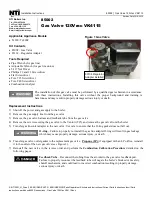
9
Installation & Operation Manual
1
Determine boiler location
(continued)
Provide air openings to room:
Knight Wall Hung Fire Tube boiler alone in boiler
room
1. No air ventilation openings into the boiler room are
needed when the total room volume is greater than the
values given for closet installations (see Table 1A). For
spaces that do NOT fit this criteria, provide one square
inch free area per 1,000 Btu/hr of boiler input.
Knight Wall Hung Fire Tube boiler in same space
with other gas or oil-fired appliances
1. Follow the National Fuel Gas Code (U.S.) or CSA B149.1
(Canada) to size/verify size of the combustion/ventilation
air openings into the space.
The space must be provided with
combustion/ventilation air openings
correctly sized for all other appliances
located in the same space as the Knight
Wall Hung Fire Tube boiler.
Do not install the boiler in an attic.
Failure to comply with the above warnings
could result in severe personal injury,
death, or substantial property damage.
2. Size openings only on the basis of the other appliances in
the space. No additional air opening free area is needed
for the Knight Wall Hung Fire Tube boiler because
it takes its combustion air from outside (direct vent
installation).
Wall mounting location
Ensure the wall for which the boiler is intended to be
mounted is composed of either, cement, brick, block, or
wooden studs spaced 16 inches apart from center. Ensure the
wall is capable of supporting at least 250 pounds for Models
056 - 286 and 300 pounds for the 400 models.
If flooding is possible, elevate the boiler sufficiently to prevent
water from reaching the boiler.
Ensure the boiler is installed in a location that minimizes the
risk of water damage due to valves, pumps, etc.
Residential garage installation
Precautions
Take the following precautions when installing the appliance
in a residential garage. If the appliance is located in a
residential garage, it should be installed in compliance with
the latest edition of the National Fuel Gas Code, ANSI Z223.1
and/or CAN/CGA-B149 Installation Code.
• Appliances located in residential garages and in
adjacent spaces that open to the garage and are not part
of the living space of a dwelling shall be installed so that
all burners and burner ignition devices are located not
less than 18 inches (46 cm) above the floor.
• The appliance shall be located or protected so that it is
not subject to physical damage by a moving vehicle.
Vent and air piping
The Knight Wall Hung Fire Tube boiler requires a special
vent system, designed for pressurized venting.
The boiler is to be used for either direct vent installation or
for installation using indoor combustion air. When room
air is considered, see Section 3, General Venting. Note
prevention of combustion air contamination below when
considering vent/air termination.
Vent and air must terminate near one another and may be
vented vertically through the roof or out a side wall, unless
otherwise specified. You may use any of the vent/air piping
methods covered in this manual. Do not attempt to install
the Knight Wall Hung Fire Tube boiler using any other
means.
Be sure to locate the boiler such that the vent and air piping
can be routed through the building and properly terminated.
The vent/air piping lengths, routing and termination method
must all comply with the methods and limits given in this
manual.
Prevent combustion air contamination
Install air inlet piping for the Knight Wall Hung Fire Tube
boiler as described in this manual. Do not terminate vent/air
in locations that can allow contamination of combustion air.
Refer to Table 1B, page 10 for products and areas which may
cause contaminated combustion air.
You must pipe combustion air to the boiler
air intake. Ensure that the combustion air
will not contain any of the contaminants
in Table 1B, page 10. Contaminated
combustion air will damage the boiler,
resulting in possible severe personal
injury, death or substantial property
damage. Do not pipe combustion air near
a swimming pool, for example. Also,
avoid areas subject to exhaust fumes from
laundry facilities. These areas will always
contain contaminants.
WARNING
WARNING
Provide clearances:
Clearances from combustible materials
1. Hot water pipes—at least 1/4" (6 mm) from combustible
materials.
2. Vent pipe – at least 1" (25 mm) from combustible
materials.
3. See FIG.’s 1-1 and 1-2 on page 8 for other clearance
minimums.
Содержание WH- 286
Страница 66: ...66 Installation Operation Manual 10 Start up Figure 10 2 Operating Instructions_ Models WH56 WH286 ...
Страница 67: ...67 Installation Operation Manual 10 Start up continued Figure 10 3 Operating Instructions_Model WH400 ...
Страница 86: ...Installation Operation Manual 86 Notes ...
Страница 87: ...Installation Operation Manual 87 Notes ...










































